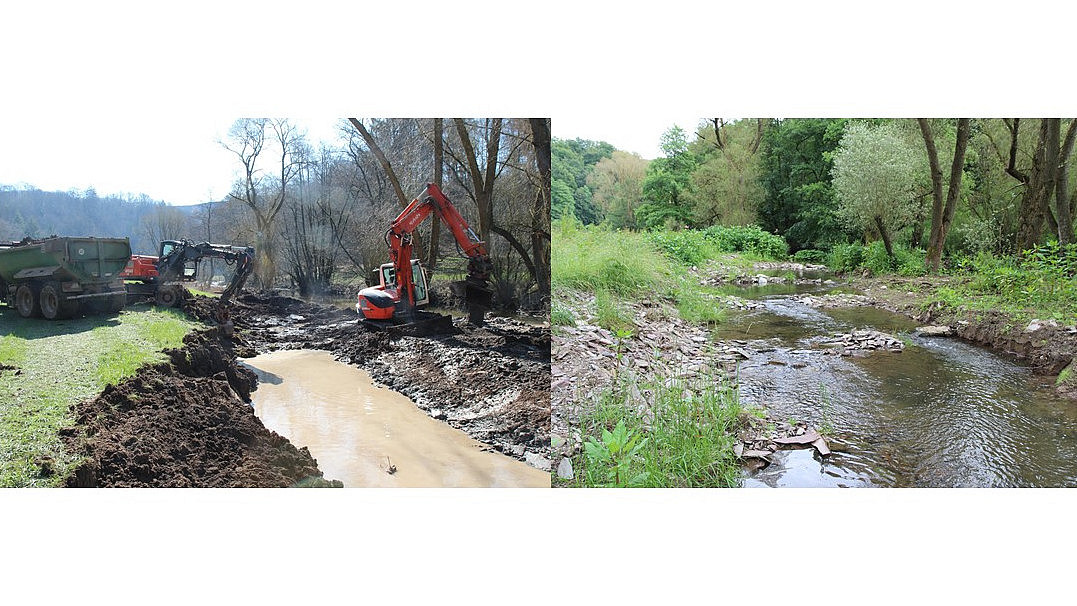This page contains automatically translated content.
End of the water highway: The Diemel may flow more naturally again
 Image: Jens Eligehausen.
Image: Jens Eligehausen."The upper Diemel is an idyllic spot. Rare animal and plant species live there. But from an ecological perspective, the river is far from a near-natural state. Yet the original goal of the EU's Water Framework Directive was for all surface waters to be in good ecological condition by 2015," reports Jens Eligehausen, a lecturer in landscape and vegetation ecology at Kassel University and co-founder of Planar e.V., the planning network for sustainable regional development.
People adapted the Diemel to their living conditions almost 200 years ago. Its course was altered, banks straightened, arable land gained or mining carried out. A corset of stone and straightening turned the Diemel into a water highway. This has displaced many plant and animal species that need flow-calmed shallow water zones and loose gravel to live.
"Of course, we can't restore the old condition 1:1. But we can turn the most important adjusting screws," Eligehausen explains. The watercourse can now shift laterally, and in addition, the formerly compacted, life-hostile bed consists of loose gravel. With this approach, Planar e.V., in cooperation with the University of Kassel and the Diemel Water Board (Marsberg), has initiated the renaturation of about 600 meters of flowing water since 2015. The implementation has been very cost-efficient: "We were able to implement our measures for a few thousand euros," reports Eligehausen, a water ecologist.
Students developed planning ideas
Eligehausen involved students of landscape planning or environmental engineering in the project as part of his courses. The students also developed their own ideas, based on three different categories of measures:
- Removal of bank stabilization to promote and restore dynamic processes.
- Initial modeling of instream structures such as gravel bars and establishment of dead wood structures
- Creation of side channels and flow-calming shallow water zones for juvenile fish, amphibians, and other semi-aquatic species
Using geographic information systems (GIS), students identified suitable areas for potential measures, with major implementation occurring in April 2020. Three side channels, three downstream connected and one oxbow connected at higher flows were created. When the fish population was checked by the University of Kassel in June 2020, the students were already able to demonstrate initial success. "We found minnows in the upper Diemel and grayling larvae upstream of the WEPA paper mill," says Eligehausen, highly pleased. "The findings show the high species- and stage-specific attachment to habitat structures that have become rare. And it shows that our measures work quickly and cost-effectively."
A model for all
The results of the "Diemel Unleashed" project have been published for open viewing at: www.diemel-entfesselt.de. Free software was used to collect the data, and the workflow was transparent for everyone to see, he said. "For me, it's about enabling other people to take action themselves without inhibitions. This also allows volunteers and local citizens to take action for their waters. This is a very attractive approach for other communities and water bodies," emphasizes Eligehausen. Together with the scientific support provided by the university, the project was also able to work cost-effectively across the board.
The approach has also met with great interest from neighboring companies. Recently, the WEPA company made one of its plots of land on the Diemel available for further renaturation. The measures on this area have already begun.
Further information:
The development of the current renaturation measures will be ecologically accompanied in the coming months as part of courses and the results will be published on the website www.diemel-entfesselt.de in the future. Currently, the website is filled with preliminary student work results and will be thoroughly revised again in the coming months.
Contact:
Jens Eligehausen
Email: eligehausen@uni-kassel.de